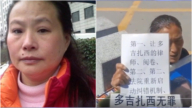【新唐人2011年3月14日讯】西藏人到底追求什么?中共镇压西藏民众的目地是什么?全世界怎么看待这件事?在西藏民众起义52周年的同时,全世界很多城市,在中共驻海外使领馆前举行了抗议活动。达赖喇嘛同一天宣布辞去西藏流亡政府的政治领袖一职,引起世界关注。一起来看看报导。
生活在青藏高原上的西藏民族有着1000多年信佛的历史。在历史上,西藏多年是独立的国家,但和中原汉族王朝保持着友好亲密的关系。唐太宗贞观年间文成公主远嫁西藏,成为松赞干布王的王后。直到清朝,七世达赖喇嘛还进献给乾隆皇帝一尊世界上最大的独木雕刻的弥勒佛像,现在还保存在北京雍和宫里。
1950年初,中共军队进驻西藏,起初承诺西藏的政治制度和达赖喇嘛、班禅的地位和职权都不变,西藏人也可以继续信仰佛教。但是,中共为了逼迫藏人就范,以殴打、活活饿死,甚至在丈夫面前强奸妇女的手段。还有在枪毙坚持信仰的喇嘛和尼姑之前,强迫他们发生性行为。这样的暴行激怒了成千上万的藏人。
1959年3月10号,30万藏人起义抗暴,遭到中共军队血腥的镇压。据西藏流亡政府和来自中国的档案,大约8600多藏人被杀。在1989年和2008年,西藏爆发了大规模的反抗,但都被中共武力镇压下去。
至今,不断有藏人通过尼泊尔、印度,逃亡到自由世界里来。有西方登山爱好者在中国边境,拍摄到中共军人开枪打死逃亡藏人,其中包括少年。
“维基解密”2010年曝光中共付钱给尼泊尔边境的军官,要求他们把逃亡的藏人抓到后送回中国。
袁红冰:“中共维持它统治的主要方法就是国家恐怖主义性质的暴力和谎言,以及一些物质欲望的利诱。那现在对西藏而言,这三种方法它们在交替的使用。而且他们现在是越来越依靠国家暴力。”
今年3月10号,在美国纽约、三藩市、印度新德里、德国布兰登堡、法国巴黎等全世界许多城市,海外的藏人、汉人和西方人举行了多个抗议活动。一些城镇的市政府还升起了西藏人的雪山狮子旗,表示对西藏人民的同情和支持。
同一天,西藏精神领袖达赖喇嘛宣布,辞去流亡政府中政治领袖的职位。
西方媒体《每日镜报》评论指出,达赖喇嘛是希望通过民主选举,让藏人自己来当家作主,他不愿看到自己死后出现有利于中共的权力空间。
西藏流亡政府中国事务负责人达瓦才仁认为,中共镇压藏族民众,是为了从根本上消灭藏族文化和信仰。
达瓦才仁:“这个问题不是一个政治问题,或者国家统一问题,根本不是这个层面的问题,而是对一个文化、一个宗教消灭。因为这个宗教、这个文化对他们来说是一种异类,因为跟共产党无神论信仰是不相容。”
西藏人权与民主促进中心在1月,发布了2010年度的西藏人权状况报告,有188名藏人在2010年因政治原因被捕,目前被关押的藏人总数达到八百多人。
新唐人记者赵心知、周天综合报导。
Tibetans’ Uprising: 52 Years Later
What do Tibetans want? Why does the CCP suppress
them? At the 52nd anniversary of the Tibetan
people’s uprising on March 10, there are protests
at Chinese embassies and consulates in cities around
the world. The Dalai Lama also resigned his
leadership position of the Tibetan Parliament-in-
exile on the same day. This has attracted
worldwide attention.
The Tibetans have been Buddhists for over a millennium.
Historically, Tibet has been an independent country,
with close a relationship with the Han dynasties.
During Taizong Emperor of Tang Dynasty’s reign,
Princess Wen Cheng married King Songtsan Gambo.
The 7th Dalai Lama made the largest single-wood
statue of Buddha Maitreya, dedicating it to
Emperor Qianlong. The statue is still stored in
Yonghe Temple in Beijing.
In early the 1950s, the CCP’s armies entered Tibet,
initially promising to maintain Tibet’s political system,
The Dalai Lama and Panchen Lama’s status,
and to allow Tibetans to continue their Buddhist faith.
The CCP soon started controlling Tibetans by beatings,
starvation and raping wives in front of their husbands.
They also forced monks and nuns to have intercourse
before executing them for refusing to give up their faith.
These atrocities infuriated the Tibetan people.
In 1959, on March 10, 300,000 Tibetans started
an uprising. They were brutally suppressed by the
CCP’s army. According to the Tibetan Parliament-
in-exile and files from China, more than 8,600
Tibetans were killed. In 1989 and 2008, large-scale
revolts broke out in Tibet, but both were violently
suppressed by CCP’s military. Tibetans have been
fleeing China via Nepal and India. Western mountain
climbers videotaped the shootings of fleeing Tibetans,
including teenagers, by CCP soldiers. According to
WikiLeaks, the CCP pays Nepalese officers
at the border to catch and send Tibetans back to China.
Historian Yuan Hongbing:
“The CCP’s principal means of maintaining control is
state terrorism, through violence, lies and material
benefits. The CCP uses the three methods
alternatively in Tibet. Now they rely more and more
on state violence.”
On March 10, in New York, San Francisco, New Dehli,
Brandenburger, Paris, and many other cities,
Tibetans, Chinese and westerners held protests.
Some municipal and township governments
even raised the flat of Tibet to show their support.
The Dalai Lama also resigned from his position
as the political leader of the Tibetan Parliament-
in-exile. The Daily Mirror commented that it hopes
the Tibetans will run their own government via
democratic elections. They don’t want his resigning
to leave a power vacuum which will benefit the CCP.
Tibetan Parliament-in-exile China Affairs Director,
Dawa Tsering, believes the CCP’s suppression of
Tibetans is an attempt to eradicate the Tibetan culture
and belief.
Tsering: “It’s not a political issue or unification issue.
It is the eradication of a culture and a religion,
because they are not compatible with CCP’s atheism.”
The Tibetan Center for Human Rights and
Democracy released a 2010 Tibetan Human Rights
report in Jan. 2011. 188 Tibetans were arrested in
2010 for political reasons, and 800 Tibetans are in
detention today.
NTD Reporters Zhao Xinzhi and Zhou Tian.























